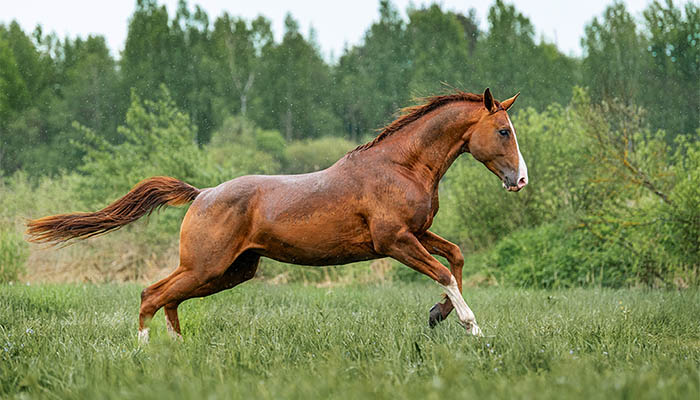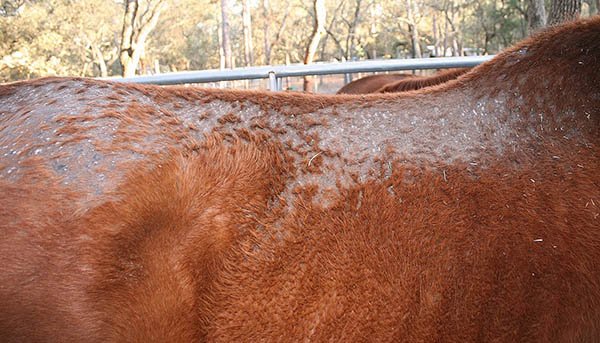
Rain rot, also known as rain scald, is a common bacterial skin condition that horses can develop when exposed to wet conditions. Because of this, rain rot frequently occurs in the spring, particularly with horses that spend most of their time turned out. Fortunately for horse owners, most cases of rain rot can be treated with topical solutions and a variety of horse husbandry methods.
Defining Rain Rot
Characterized by patches of rough bumps and scabs on the skin, rain rot often appears over the topline (withers, back, and croup) of your horse. It is a bacterial infection of the bacteria Dermatophilus congolensis, not a fungal infection as some equestrians think. Typically the bacteria live in the soil, but they can also live on your horse’s skin in a dormant state. Warm, wet conditions, such as rainy spring weather, can cause the bacteria to provoke an inflammatory response in the skin. The inflammation causes scabs, bumps, and lesions on the horse’s skin, resulting in a rough coat that appears to stand up in places where the scabs contain some of the horse’s fur. Many times, the infection appears to “drip” off of the horse, compounding in the wettest areas of the horse’s back, neck, and hips.

Severe rain rot infections may affect multiple layers of the horse’s skin, making the scabs larger and more pronounced. The painful removal of the scabs may cause the hair to fall out, giving horses a mangey appearance. If the infection progresses without treatment, the crusty skin and fur can become painful to the touch. If this happens, it is recommended that your horse is not ridden or worked until the condition improves.
Treating Rain Rot
The best treatment for rain rot will depend on the level of your horse’s infection. Minor infections can be treated with topical ointments, while more severe rain rot cases may require veterinary intervention.
When you first notice patches of rain rot on your horse’s skin, it is vital to take action immediately. Begin by gently currying your horse in the affected area, removing the loose skin and hair. Be aware that the removal of the scabs may be painful, so carefully monitor your horse’s demeanor during this process.
Next, wash your horse with an antibacterial shampoo, such as Banixx Medicated Horse Shampoo with Collagen, Absorbine Silver Honey Medicated Shampoo, or Durvet Medicated Antibacterial and Antifungal Shampoo. This will help cleanse the coat while killing harmful bacteria. After rinsing the shampoo, promptly towel dry the coat. After the coat is thoroughly dried, an antimicrobial skin care spray can be applied to soothe the skin, promote hair regrowth, and create an inhospitable environment for the rain rot bacteria. Products such as Zephyr’s Garden Tea Tree Tonic Spray, Equiderma Skin Lotion, and Spurr’s Big Fix Antiseptic Spray are all popular rain rot treatments.
Make sure that you wash all of your grooming equipment and blankets because they can hold onto the bacteria and cause reinfection to occur—and they can even cause the infection to pass from horse to horse. After the initial treatment, you should monitor your horse closely, and clean and apply topical ointments on a regular basis until the infection has subsided and the scabs have healed. Baths with antibacterial shampoo can be repeated weekly as needed.
In more extreme cases of rain rot, your veterinarian may suggest a skin biopsy to determine the exact cause of the infection. Once the specific bacteria has been identified, topical antibiotics are often prescribed. Depending on your horse’s health, your veterinarian may utilize antibiotic injections to jumpstart the healing process.
Preventing Rain Rot
When it comes to rain rot, proper prevention is one of the best ways to keep your horse’s skin healthy. Nourish the skin from the inside out with a supplement that contains high levels of omega-3 fatty acids, such as StableFeed Spirulina Chia – Immune Support or Omega Fields Omega Horseshine. These essential fatty acids promote skin and coat health, while naturally decreasing the inflammatory response from an active bacterial infection during a rain rot outbreak. You can learn more about omega-3 supplementation on our blog post, Adding Omega-3 Fatty Acids to Your Horse’s Diet.
Additionally, it is crucial to control your horse’s exposure to environmental factors, to the best of your ability. Whenever possible, try to keep your horse out of the rain, or provide adequate shelter for them during inclement weather. A turnout sheet can prevent your horse from becoming too wet, but it is essential to remove the sheet after turnout in order to minimize moisture build-up and encourage airflow to the skin. Limiting your horse’s access to muddy areas can also lessen the likelihood of a rain rot infection.
Some topical coat products, including Equiderma Daily Defense Dry Shampoo, have been shown to inhibit the growth of skin infections (for example, rain rot). As another effective preventative measure, consider integrating a dry shampoo into your daily grooming routine.
At The Cheshire Horse, we carry everything you need to care for your horse while preventing and treating skin ailments such as rain rot. Our helpful and experienced sales staff can help you select the products you need to promote health and wellness in your horse.



I enjoy your short stories like this one since they have a good vibe. Continue to share more in the future!
Wow, what a wonderful post. This was too much information for me